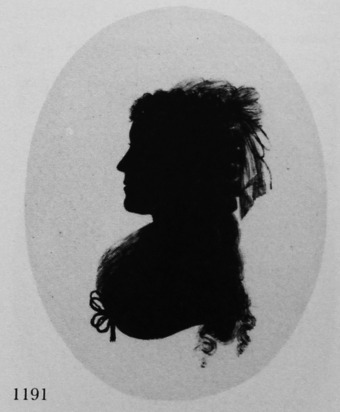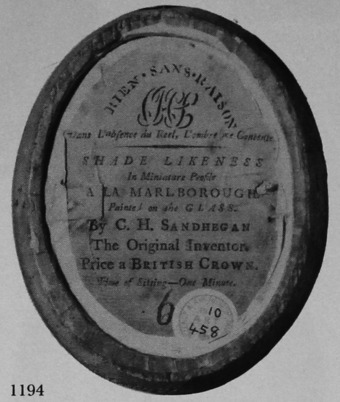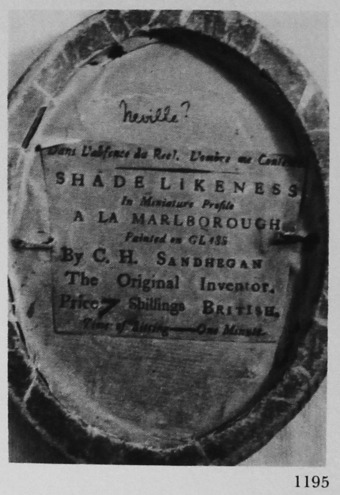Sandhegan, C. H. (McKechnie Section 3)
See also Section Two
An artist whose few known silhouettes are labelled 'C. H. Sandhegan', although three authorities list an artist named Sandhegan, in each case with different initiais. Jackson (Dictionary) records M. Sandhegan; Woodiwiss (British Silhouettes), C. R. Sandhegan; Mayne, M. R. Sandhegan. It seems reasonable to assume that we are considering only one artist, although (remarkably) he is known by four different sets of initials. 'M' and 'M. R.' could be misreadings of 'Mr' (although I have seen no record of a 'Mr Sandhegan' on a trade label or in an advertisement); also, 'C. R.' could be a misreading of 'C. H.'
None of the artist's three known trade labels (two illustrated) gives any address, but Jackson states that 'M. Sandhegan' worked in Marlborough Street. The similarity of the wording of these trade labels with that of the trade label of the contemporary Irish artist W. L. Holland, who tells us that he worked in Dublin, suggests that Sandhegan also worked in Dublin. On their labels both artists use the phrases 'à la Marlborough' (which might indicate residence in Marlborough Street) and 'dans l'absence du réel, l'ombre me contente'. (See the entry on Holland for a fuller discussion). Marlborough Street did exist as far back as the 1780s, but there are no Dublin street directories for the period before 1834 which would confirm Sandhegan's residence in this street, and, not surprisingly, he is not listed in the lists of `Merchants and Traders' (the only occupational register for the relevant period) in Dublin Public Libraries.
I have deduced the period during which Sandhegan seems to have worked from the appearance of the extant silhouettes painted on glass.
Sandhegan painted on the under surface of flat glass, backing his work either with silk or with plaster slabs which are smooth on both sides. He made very little use of the needle to achieve lightness of touch; only one known example shows any sign of this technique. He achieved transparency by the constant use of the brush and thinned pigment. On one illustrated example the man's frock is not painted in solid black, but with thick strokes of pigment brushed across the body of the profile. Hair is painted in the same way, without the use of the needle.
One early silhouette is painted in a style reminiscent of T. Rider (q.v.). Sandhegan's style also shows an affinity with that of W. L. Holland, though we cannot say who influenced whom. As Holland says on his trade label that he works in a 'Composition in Watercolour much Superiour to any yet attempted in Oil Colour on Glass', it is possible that he is referring to Sandhegan's work, some of which may have been painted in oil.
Early works (dating from the late 1780s) have bust-line terminations; examples of later work which have been seen do not. Otherwise, no ruling can be laid down about the shape of bust-line terminations: one of the two illustrated examples has a double-loop concavity, similar to Mrs Beetham's type, though the silhouette is readily distinguishable from her work, since she worked on convex glass, whereas Sandhegan worked on flat glass.
One silhouette (not illustrated) is, typically, painted on the under surface of flat glass (though on a piece of glass larger than that of any of the illustrated examples). It is almost half-length, being similar in this respect to the illustrated silhouette of (possibly) a member of the Neville family, but with a bust-line termination in a single convex arc. It is in a large oval frame, with six black and gold lines of verre églomisé.
Sandhegan's frames are characteristic. Though they appear, at a casual glance, to be the standard oval hammered brass frames, they are found on closer examination to be of wood, faced with plaster gilded to simulate brass.
I have already referred to the similarity of the wording of Sandhegan's two trade labels to that on Holland's label. Trade Label No. 1 was used c. 1788-91. No. 2 (similar to No. 1, but without the monogram at the top and printed in red on brown paper) gives the price ‘Six Shillings — BRITISH’; it was probably used c. 1791. No. 3 is similarly worded, but the top has been cut off and the price of 7s. has been added; this label appears to have been used 1792-96.
1193 1191
Ills. 1191-1195

Unknown woman
Silhouette painted on flat glass
1788-91
4 x 3in./102-77mm.
Trade Label No. 1
Frame: wood, faced with gilded plaster
The style is similar to that of T. Rider (q. v.).
National Gallery of Ireland, No. 7158

Unknown woman
Silhouette painted on greenish flat glass, backed with silk
1790-91
4 x 3in./102 x 77mm.
Trade Label No. 1
Frame: wood, faced with gilded plaster
Author’s collection

Unknown man, possibly a member of the Neville family
Silhouette painted on flat glass, with verre églomisé border, backed with plaster
c. 1794-95
2¾ x 2in./70 x 51mm.
Trade Label No. 3
There is a companion silhouette of a woman, with the same trade label, in the same collection.
T. E. F. Sainsbury collection

Trade Label No. 1 of C. H. Sandhegan, from the silhouette shown in 1191.
National Gallery of Ireland, No. 7158

Trade Label No. 1 of C. H. Sandhegan.
T. E. F. Sainsbury collection
